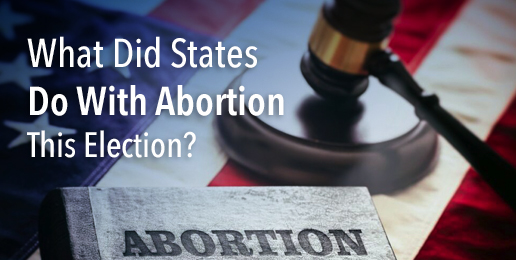Written by Alyssa Sonnenburg
The 2024 Presidential Election was vital not only because of the Presidency but also because of 10 states that had abortion rights on the ballot.
In the midst of the excitement after Trump’s victory, you may have missed the results of these ballot measures.
Arizona, Colorado, Maryland, Missouri, Montana, Nevada, New York, Florida, Nebraska, and South Dakota all had abortion-related ballot measures that sought to affirm the “right” of a woman to an abortion.
Arizona’s abortion ballot measure, Proposition 139, passed with 61.6% of the vote. The state of Arizona now allows abortion up to fetal viability or later to protect the life of the mother. Essentially, this Proposition allows abortion through all 9 months of pregnancy.
Colorado’s abortion ballot measure, Amendment 79, also passed with 61.9% of the vote, allowing abortion with no gestational limit. This means abortion is allowed in Colorado through all nine months of pregnancy. In addition to this, Amendment 79 allows for public funds to cover abortion costs.
Maryland’s ballot measure, Question 1, passed with 75.1% of the vote, allowing abortion through all nine months of pregnancy. Missouri’s Amendment 3 passed with 51.6% support to allow abortion until fetal viability. Montana’s CI-128 passed with 56.8% of the vote, also allowing abortion until fetal viability.
The state of Nebraska had two ballot initiatives to vote on:
More positively, Nebraska’s Initiative 434 passed with 53.8% of the vote banning abortion in the second and third trimesters except in medical emergencies or cases of rape or incest. Essentially, this initiative enshrines in Nebraska state law a 12-week ban on abortion.
Nebraska’s Initiative 439 failed with 51.3% of the vote which would have overturned Nebraska’s 12-week ban in favor of allowing abortion until fetal viability.
Nevada’s Question 6 passed with 64.2% support to allow abortion until fetal viability or to protect the life or health of the mother.
New York’s Proposition 1 passed with 72.3% support, allowing abortion until fetal viability. In addition to this, the Proposition amends
“the constitution’s equal rights amendment to include anti-discrimination protections for pregnancy, pregnancy outcomes, and reproductive healthcare and autonomy. Amendment backers contend these anti-discrimination protections would bar the NY Legislature from enacting abortion restrictions.”
South Dakota’s Amendment G would have
“overturned the state’s current ban and imposed escalating restrictions on abortion further into a pregnancy, allowing abortion without any restrictions within the first trimester of a pregnancy, abortion in the second trimester only for a reason that’s ‘reasonably related to the physical health’ of the pregnant person, and abortion in the third trimester only when necessary to the pregnant person’s life or health.”
Essentially, this ballot measure would have allowed abortion through all nine months of pregnancy. Thankfully, this ballot measure failed with 61% of the vote.
Last but certainly not least, Florida had the most historic moment during this election.
Florida’s Amendment 4 would have allowed abortion through all nine months of pregnancy for the health of the mother (or until fetal viability). This ballot measure would have nullified the state’s 6-week heartbeat ban and made Florida a radical abortion state.
This ballot measure failed with 57% of the vote (60% of the vote was needed for this to pass). The Economist reported that Florida is the first state in the country that rejected abortion rights in a post-Roe America.
We praise the Lord and celebrate that Florida, Nebraska, and South Dakota had victories on these ballot measures, yet we mourn the loss of life that will occur in the other seven states as a result of their radical abortion amendments.
America has a long way to go and a long fight ahead until we live in a completely abortion-free nation.

